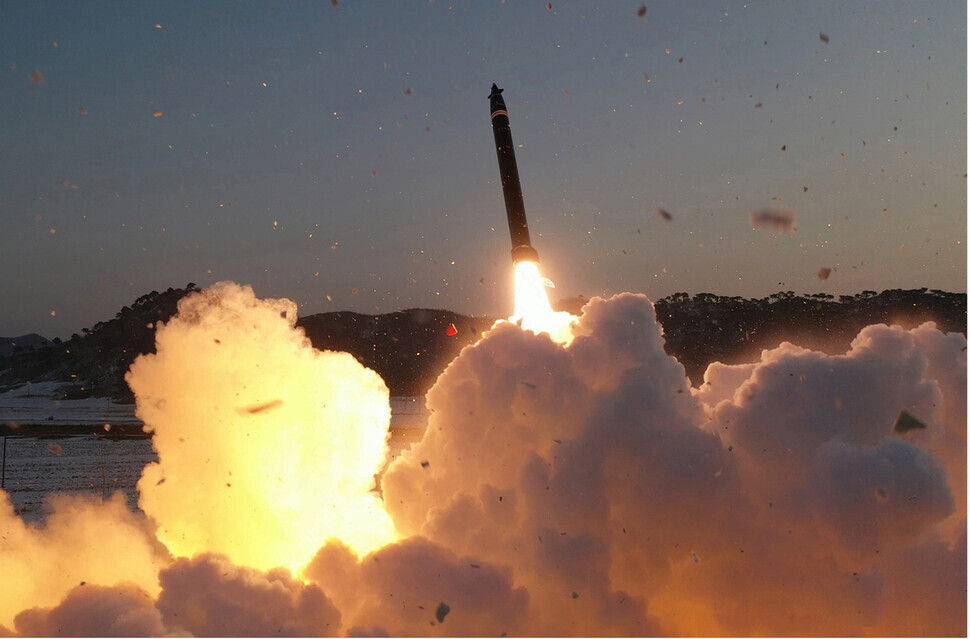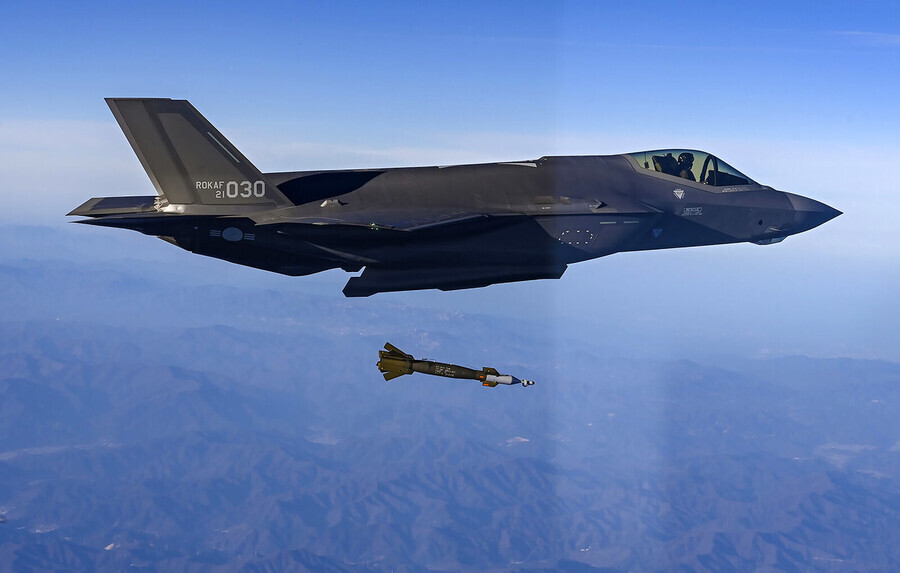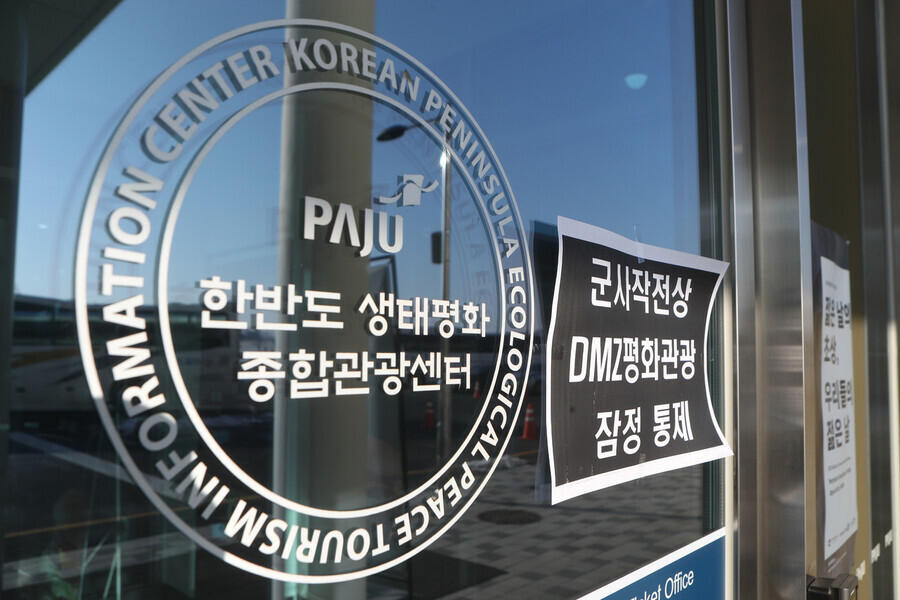hankyoreh
Links to other country sites 다른 나라 사이트 링크
[News analysis] Lacking mediator, two Koreas engage in hostile one-upmanship

The leaders of the two Koreas are in an escalating contest of aggressive rhetoric. They do not hesitate to refer to each other as the “undoubted enemy,” and are going so far as to use phrases such as “preparations for war,” and “the ultimate end.”
Words are not the only things being thrown around. North Korea, which shot off more missiles in 2022 than it had in any year in history, is proposing “mass production” of tactical nuclear weapons as well as an “exponential increase” of its nuclear arsenal as the foundation for “clarifying the epochal strategy of the development of nuclear force and national defense for 2023.”
South Korea also plans to invest 331 trillion won (US$263.98 billion) over the next five years to boost its military capabilities.
It seems like ages ago that the leaders of North and South Korea met in 2018 and discussed the possibility of the end of hostile activities and a non-aggression pact, as well as a slow progression toward disarmament.
What lies on the horizon only proves that worrying that the Korean Peninsula, which some 80 million people call home, will fall into a crisis, is not excessive. The first half of this year is already worrisome.
South Korea and the US have already begun strengthening and expanding joint drills, and plan to conduct more than 20 field training exercises at the level of past Foal Eagle exercises.
The Foal Eagle exercises were some of the largest military exercises conducted in the world, involving around 300,000 South Korean and US troops. It is uncertain whether the drills this year will be that large in scale, but it is highly likely that they will be theater-level exercises that assume all-out war.
In addition, South Korea and the United States will include in the joint exercises preparations for use of nuclear weapons by North Korea, which means that the size and frequency of US strategic asset deployment will increase.
Another concern is that North Korea is likely to respond militarily. North Korea has always protested the joint South Korea-US exercises, but the situation has taken a drastic turn since the fall of 2022.
In the past, North Korea focused on diplomatic criticism and demands for the halt of such exercises, but since the fall of last year, it has been responding to the joint military exercises with military threats, much in the vein of “an eye for an eye, a tooth for a tooth.”
The turning point was when North Korea adopted its nuclear weapons policy in the form of a decree of the Supreme People’s Assembly on Sept. 8, 2022. Leader Kim Jong-un stated in a speech directed to the assembly that in putting forth such legislation, the North had “put an end to the era when the US imperialists unilaterally imposed nuclear threat.” Underlying this proclamation is a sense of confidence that North Korea has achieved a “balance of power” through the building of its nuclear arsenal and relevant legislation.
In November 2022, North Korea’s Foreign Ministry repeatedly criticized the South Korea-US joint drills, stating, “If the U.S. continuously persists in the grave military provocations, the DPRK will take into account more powerful follow-up measure,” which feels like a preview for a crisis on the Korean peninsula. It’s a worrying prospect.

There have been several times Korea has found itself in crisis and on the brink of war in the past. However, for the most part, the light at the end of the tunnel was visible previously.
The crisis Korea is facing now is serious, as there doesn’t appear to be an exit ramp.
In the past, various factors contributed to the shift from confrontation to conservation and from crisis to opportunity.
To begin with, North Korea often played games of brinkmanship and escalated conflict on the Korean Peninsula to pressure Seoul and Washington to come out and participate in dialogue. The Americans sometimes practiced the same strategy.
The calculating schemes of both sides coalesced into a dramatic chemical reaction in 2017 and 2018, which brought around a surprising turn of events.
Throughout 2017, President Donald Trump of the US and Kim Jong-un of North Korea exchanged verbal vitriol and shows of force as if to prove that the two could not exist under the same sky.
These two leaders began to flaunt their closeness in 2018, as if what had happened one year earlier was all water under the bridge. But after meeting with the US leader twice in 2019 — once in February and again in June — Kim Jong-un judged that he had been merely playing along with the US’ demands, and turned to a “new path” in 2020.
He has been staying on that path for three years now, a path he has taken after deciding to not care about relations with Washington or Seoul, to make the North Korean economy self-reliant, and to make diplomatic decisions mainly with China and Russia.
But most important of all: If North Korea’s nuclear weapons used to function mainly as a diplomatic bargaining chip, as of now and for what seems to be the near future, the country’s nuclear weapons are becoming more than just a means to an end.
Another factor that differentiates this crisis from those of the past is that there is no appropriate mediator of the conflict. In 1994, when the two Koreas were on the brink of war, former US President Jimmy Carter served as a mediator.
When the Kim Jong-il regime and the George W. Bush administration were sharply divided in the early 2000s, The Kim Dae-jung and Roh Moo-hyun administrations and the Chinese government worked hard to manage the crisis and mediate dialogue between North Korea and the United States.

In the face of the impending sense of war between the two Koreas triggered by North Korea’s shelling of Yeonpyeong Island in November 2010, the US helped calm South Korea, while China held North Korea back.
In the brinkmanship game in which Kim Jong-un and Donald Trump participated in from the second half of 2017 to the beginning of 2018, the Moon Jae-in administration acted as a mediator, facilitating the conflict and jumpstarting dialogue.
However, right now, things have changed dramatically. With North Korea having lost interest in dialogue, asking them to participate in talks with South Korea and the United States no longer holds the diplomatic power it used to have.
Expecting former Presidents Moon Jae-in and Donald Trump to act as mediators is also difficult. Not only is Kim Jong-un more than slightly disappointed with these former presidents, but political polarization is becoming a big problem in both South Korea and the United States.
To make matters worse, South Korea, the States and Japan have joined forces to point fingers at North Korea, China and Russia, which are themselves busy admonishing the other three countries.
With internal conflicts, inter-Korean conflicts, and international conflicts overlapping, it is becoming increasingly difficult to make a breakthrough in the situation on the Korean Peninsula.
It is also worth noting that crisis on the Korean Peninsula is becoming more and more centered on inter-Korean relations. In the past, war crises originated mainly from North Korea-US relations.
Examples include the first half of 1994, when Washington was contemplating attacking North Korea and North Korea was ready to commit to war, when there was a collision between the Bush administration’s hardline policy towards North Korea and the Kim Jong-il regime attempted to develop nuclear arms in 2003, and the crisis of 2017.

But starting in 2020, the center of conflict has shifted to inter-Korean relations. With the inauguration of President Yoon Suk-yeol in May 2022, this focus is quickly becoming more prominent.
The Kim Jong-un regime is blatantly threatening South Korea with its tactical nuclear weapons, while the Yoon administration is pleading with the US to share its nuclear arms in some way.
For the first time since the Korean War, missiles have fallen into both countries’ waters, and drones have traveled to and from the DMZ. It has gotten to the point where the South Korean president instructed that examinations of suspending the validity of the Sept. 19 military agreement be made if North Korea makes another provocation and invades the South’s territory.
The safety pins put in place to prevent accidental clashes and the prospect of war, are coming dislodged.
The aggressive and increasingly intense confrontations between the South Korea-US alliance and North Korea beg a number of questions.
Can you really preserve peace by demonizing the other side and showing off one’s military prowess? Are words and actions meant to prevent war having the opposite effect and heighten the risk of conflict?
Are the joint exercises and the military buildup that South Korea and the US are focusing on under the pretense of “normalization” really stabilizing the security of the Korean Peninsula?
Do North Korea’s provocative words and actions match its self-proclaimed “People First” slogan?
There’s been plenty of talk that once signs of an opponent’s attack are detected, preemptive strikes are a possibility. However, has anyone considered the possibility that humans may misjudge the situation, or a machine may malfunction?
North Korea said that it will be able to use tactical nuclear weapons even in the event of a non-nuclear attack from South Korea and the US, but do they know what the consequences will be for such actions?
South Korea and the US say they will respond “overwhelmingly” to end the Kim Jong-un regime if North Korea uses its tactical nuclear weapons, but have they thought about how they will do it and what damage will be wrought on the people of Korea if they do so?
Who will compensate for the horrific damage that innocent people will suffer in the event of a war? And how?
Do South Korea, North Korea, and the US have the will and the ability to manage crisis situations reliably, when there are no proper communication channels?
As obvious as this statement may be, a nation’s basic responsibility lies in protecting the safety and lives of its people. However, the reality is that the governments of both South and North Korea are engaging in competition, loudly shouting that they will be able to go ahead with war.
Both South Korean and North Korean leaders are supporting the maxim, “If you want peace, prepare for war,” as if it were a motto, encouraging hostility toward the other party and using it politically.

But now is the best time to change course. We need to do away with the rhetoric where we threaten to end each other. Instead, we must face the reality that signs of a crisis that could even lead to war are already piling up.
If, from now on, crises are not managed and prevented one by one, then we must heed the warning that a catastrophe could really occur. The current situation on the Korean Peninsula has reached such a boiling point that any small confrontation could quickly turn into a major escalation.
We should also stop playing the game of chicken where heightening the opponent’s fears is seen as winning. Instead, it’s important to realize that wisdom is urgently needed now, and that one small concession could become a stepping stone that brings great rewards.
Looking back, there are plenty of issues the governments of both South and North Korea need to work on. A case in point is the financial difficulties faced by the people, the importance of which is acknowledged unanimously by both South and North Korean officials.
However, the issue of people's livelihoods is not separate from the crisis on the Korean Peninsula. This is because Korean people would be able to enjoy a better quality of life than now if the two Koreas used their precious resources to solve the difficulties faced by the public instead of squandering them on preparing for war.
What about the climate crisis? This is a global problem that affects the entire planet irrespective of borders. In fact, the Korean Peninsula is one of the most vulnerable regions in the world when it comes to climate change.
However, it’s difficult to separate the climate crisis from military activities. This is especially relevant on the Korean Peninsula, one of the places with the highest military activity in the entire world.
Therefore, the leaders of the two Koreas should not be pleased when watching their military drills that involve the use of various weapons but instead realize how the carbon emissions emitted by these weapons are making our future even darker.
I apologize to readers for only adding to worries so early in the new year.
It is said that peace is not given, but created. I bid my new year’s greetings with the hope that we can gather strength and wisdom in the direction of that path.
By Cheong Wook-Sik, director of the Hankyoreh Peace Institute and director of the Peace Network
Please direct questions or comments to [english@hani.co.kr]

Editorial・opinion
![[Editorial] Penalties for airing allegations against Korea’s first lady endanger free press [Editorial] Penalties for airing allegations against Korea’s first lady endanger free press](https://flexible.img.hani.co.kr/flexible/normal/500/300/imgdb/original/2024/0502/1817146398095106.jpg) [Editorial] Penalties for airing allegations against Korea’s first lady endanger free press
[Editorial] Penalties for airing allegations against Korea’s first lady endanger free press![[Editorial] Yoon must halt procurement of SM-3 interceptor missiles [Editorial] Yoon must halt procurement of SM-3 interceptor missiles](https://flexible.img.hani.co.kr/flexible/normal/500/300/imgdb/child/2024/0501/17145495551605_1717145495195344.jpg) [Editorial] Yoon must halt procurement of SM-3 interceptor missiles
[Editorial] Yoon must halt procurement of SM-3 interceptor missiles- [Guest essay] Maybe Korea’s rapid population decline is an opportunity, not a crisis
- [Column] Can Yoon steer diplomacy with Russia, China back on track?
- [Column] Season 2 of special prosecutor probe may be coming to Korea soon
- [Column] Park Geun-hye déjà vu in Yoon Suk-yeol
- [Editorial] New weight of N. Korea’s nuclear threats makes dialogue all the more urgent
- [Guest essay] The real reason Korea’s new right wants to dub Rhee a founding father
- [Column] ‘Choson’: Is it time we start referring to N. Korea in its own terms?
- [Editorial] Japan’s rewriting of history with Korea has gone too far
Most viewed articles
- 160% of young Koreans see no need to have kids after marriage
- 2Presidential office warns of veto in response to opposition passing special counsel probe act
- 3Months and months of overdue wages are pushing migrant workers in Korea into debt
- 4[Editorial] Penalties for airing allegations against Korea’s first lady endanger free press
- 5Japan says it’s not pressuring Naver to sell Line, but Korean insiders say otherwise
- 630th anniversary Wednesday Demonstration pushed out of memorial site by far-right
- 7OECD upgrades Korea’s growth forecast from 2.2% to 2.6%
- 8At heart of West’s handwringing over Chinese ‘overcapacity,’ a battle to lead key future industries
- 9[Reporter’s notebook] In Min’s world, she’s the artist — and NewJeans is her art
- 10[Special reportage- part I] Attending the funeral of the victim of a South Korean war crime in Vietn